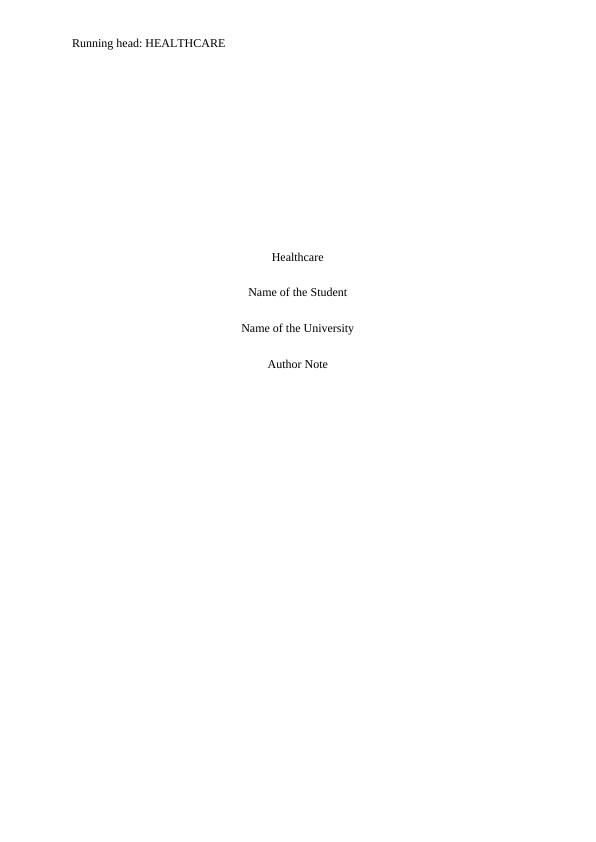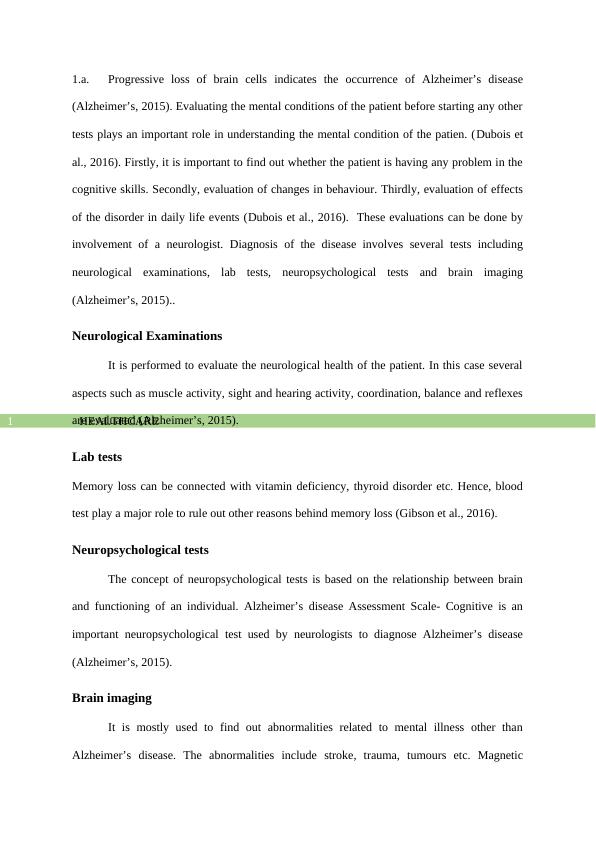Alzheimer's Disease: Diagnosis, Treatment, Risk Factors and Prevention
Added on 2022-10-06
8 Pages2126 Words51 Views
Running head: HEALTHCARE
Healthcare
Name of the Student
Name of the University
Author Note
Healthcare
Name of the Student
Name of the University
Author Note

HEALTHCARE1
1.a. Progressive loss of brain cells indicates the occurrence of Alzheimer’s disease
(Alzheimer’s, 2015). Evaluating the mental conditions of the patient before starting any other
tests plays an important role in understanding the mental condition of the patien. (Dubois et
al., 2016). Firstly, it is important to find out whether the patient is having any problem in the
cognitive skills. Secondly, evaluation of changes in behaviour. Thirdly, evaluation of effects
of the disorder in daily life events (Dubois et al., 2016). These evaluations can be done by
involvement of a neurologist. Diagnosis of the disease involves several tests including
neurological examinations, lab tests, neuropsychological tests and brain imaging
(Alzheimer’s, 2015)..
Neurological Examinations
It is performed to evaluate the neurological health of the patient. In this case several
aspects such as muscle activity, sight and hearing activity, coordination, balance and reflexes
are evaluated (Alzheimer’s, 2015).
Lab tests
Memory loss can be connected with vitamin deficiency, thyroid disorder etc. Hence, blood
test play a major role to rule out other reasons behind memory loss (Gibson et al., 2016).
Neuropsychological tests
The concept of neuropsychological tests is based on the relationship between brain
and functioning of an individual. Alzheimer’s disease Assessment Scale- Cognitive is an
important neuropsychological test used by neurologists to diagnose Alzheimer’s disease
(Alzheimer’s, 2015).
Brain imaging
It is mostly used to find out abnormalities related to mental illness other than
Alzheimer’s disease. The abnormalities include stroke, trauma, tumours etc. Magnetic
1.a. Progressive loss of brain cells indicates the occurrence of Alzheimer’s disease
(Alzheimer’s, 2015). Evaluating the mental conditions of the patient before starting any other
tests plays an important role in understanding the mental condition of the patien. (Dubois et
al., 2016). Firstly, it is important to find out whether the patient is having any problem in the
cognitive skills. Secondly, evaluation of changes in behaviour. Thirdly, evaluation of effects
of the disorder in daily life events (Dubois et al., 2016). These evaluations can be done by
involvement of a neurologist. Diagnosis of the disease involves several tests including
neurological examinations, lab tests, neuropsychological tests and brain imaging
(Alzheimer’s, 2015)..
Neurological Examinations
It is performed to evaluate the neurological health of the patient. In this case several
aspects such as muscle activity, sight and hearing activity, coordination, balance and reflexes
are evaluated (Alzheimer’s, 2015).
Lab tests
Memory loss can be connected with vitamin deficiency, thyroid disorder etc. Hence, blood
test play a major role to rule out other reasons behind memory loss (Gibson et al., 2016).
Neuropsychological tests
The concept of neuropsychological tests is based on the relationship between brain
and functioning of an individual. Alzheimer’s disease Assessment Scale- Cognitive is an
important neuropsychological test used by neurologists to diagnose Alzheimer’s disease
(Alzheimer’s, 2015).
Brain imaging
It is mostly used to find out abnormalities related to mental illness other than
Alzheimer’s disease. The abnormalities include stroke, trauma, tumours etc. Magnetic

HEALTHCARE2
resonance imaging (MRI) and Computerized tomography scan (C.T. scan) are normally used
in this case (Alzheimer’s, 2015).
Positron emission tomography (PET) is used to find out the degeneration of brain
cells. Fluorodeoxyglucose PET scan is used to find out the areas in brain where nutrient
metabolism is significantly and it is an important part to distinguish Alzheimer’s disease from
other dementias (Alzheimer’s, 2015).
1.b. It is important to develop treatment measures which has specificity towards a
particular disease. According to several studies, similar symptoms of Alzheimer’s syndrome
and depression make it challenging to the patients to diagnose the problem specifically. The
Addenbrooke’s Cognitive Examination- Revised (ACE-R) is a screening test of dementia
which can be implemented to identify the difference between Alzheimer’s disease and
depression (Rotomskis et al., 2015). Several studies reported that ACE-R is a useful tool
which is accurate enough to detect patients with Alzheimer’s disease and differentiate them
from depression (Rotomskis et al., 2015). Neuropsychological analysis of individuals
diagnosed with depression and Alzheimer’s disease indicated the distinct differences in ACE-
R results. Alzheimer’s disease is characterized by severe impairment in attention and
orientation along with language and memory subsets, and moderate impairment in verbal
fluency (Rotomskis et al., 2015). On the other hand, depression is characterized as mild
impairment in the ACE-R score which includes low scores in verbal fluency and memory
related tasks (Rotomskis et al., 2015).
2. According to Australian Bureau of Statistics (2019), Alzheimer’s disease and
dementia are found to be the reason behind a significant number of death in Australia in
2013. The report describes that the death rate due to Alzheimer’s increased around 32%
during 2009-2013. Moreover, 7.4% of total death was occurred due to problems related to
resonance imaging (MRI) and Computerized tomography scan (C.T. scan) are normally used
in this case (Alzheimer’s, 2015).
Positron emission tomography (PET) is used to find out the degeneration of brain
cells. Fluorodeoxyglucose PET scan is used to find out the areas in brain where nutrient
metabolism is significantly and it is an important part to distinguish Alzheimer’s disease from
other dementias (Alzheimer’s, 2015).
1.b. It is important to develop treatment measures which has specificity towards a
particular disease. According to several studies, similar symptoms of Alzheimer’s syndrome
and depression make it challenging to the patients to diagnose the problem specifically. The
Addenbrooke’s Cognitive Examination- Revised (ACE-R) is a screening test of dementia
which can be implemented to identify the difference between Alzheimer’s disease and
depression (Rotomskis et al., 2015). Several studies reported that ACE-R is a useful tool
which is accurate enough to detect patients with Alzheimer’s disease and differentiate them
from depression (Rotomskis et al., 2015). Neuropsychological analysis of individuals
diagnosed with depression and Alzheimer’s disease indicated the distinct differences in ACE-
R results. Alzheimer’s disease is characterized by severe impairment in attention and
orientation along with language and memory subsets, and moderate impairment in verbal
fluency (Rotomskis et al., 2015). On the other hand, depression is characterized as mild
impairment in the ACE-R score which includes low scores in verbal fluency and memory
related tasks (Rotomskis et al., 2015).
2. According to Australian Bureau of Statistics (2019), Alzheimer’s disease and
dementia are found to be the reason behind a significant number of death in Australia in
2013. The report describes that the death rate due to Alzheimer’s increased around 32%
during 2009-2013. Moreover, 7.4% of total death was occurred due to problems related to

End of preview
Want to access all the pages? Upload your documents or become a member.
Related Documents
Alzheimer’s Disease | Presentationlg...
|1
|1591
|29
Alzheimer’s Disease: Symptoms, Stages, Diagnosis and Treatmentlg...
|13
|734
|351
Analyze And Evaluate The Health Conditionslg...
|5
|1147
|16
The imaging techniques such as magneticlg...
|5
|1010
|15
Use of Music Therapy in Dementia: A Case Studylg...
|2
|993
|159
Use of Music Therapy in Dementialg...
|4
|1031
|77
